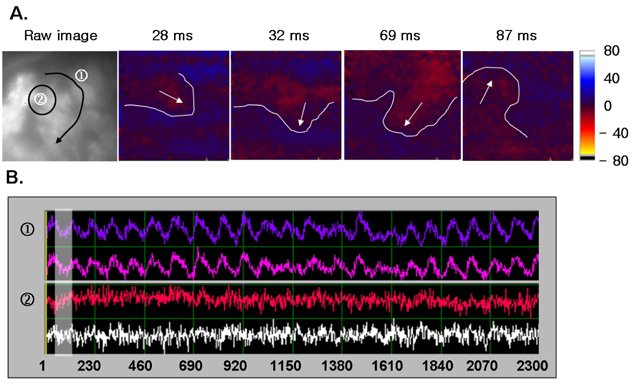Yonsei Med J.
2006 Oct;47(5):672-679. 10.3349/ymj.2006.47.5.672.
The Effect of Cryoinjury on Ventricular Tachycardia in the Swine Right Ventricle
- Affiliations
-
- 1Cardiology Division, Yonsei Cardiovascular Hospital and Research Institute, Seoul, Korea. mhlee@yumc.yonsei.ac.kr
- KMID: 1381248
- DOI: http://doi.org/10.3349/ymj.2006.47.5.672
Abstract
- This study was performed to assess the influence of the cryoinjury on the dynamics of wavefronts and to determine whether they can convert ventricular fibrillation (VF) to ventricular tachycardia (VT) in fibrillating right ventricular (RV) of swines using an optical mapping system. A cryoinjury with a diameter of 12 mm was created on the epicardium of perfused RV of swines (n = 6) and optical mapping were taken from baseline until 10 minutes after the cryoinjury. Out of 35 cryoinjuries, the images were possible to be interpreted in 32. The optical action potential could not be observed in either the cryoinjury or peri-injury sites at 1 and 3 minutes, was observed in only the cryoinjury site at 5 minutes, and recovered in both sites at 10 minutes. The cycle length of the tachycardia was 135.9 +/- 23.6 msec at baseline, 176.2 +/- 79.3 msec at 1 minute, 187.6 +/- 97.9 msec at 3 minutes, 185.5 19.2 msec at 5 minutes, and 152.1 +/- 64.1 msec at 10 minutes. The cycle lengths at 1, 3, and 5 minutes after the cryoinjury were significantly more prolonged than that at baseline (p = 0.001, p = 0.006, p = 0.016). After the cryoinjury, the VF changed to VT in 9 (28.0%), and terminated in 2 (6.3%). These changes were observed mainly within 5 minutes after cryoinjury. The cryoinjury had anti-fibrillatory effects on the tissue with VF. This phenomenon was related to a decreasing mass and stabilizing wavefronts.
MeSH Terms
Figure
Cited by 1 articles
-
Mid-Term Results of Reconstruction of the Right Ventricular Outflow Tract Using Cryopreserved Homografts
Young-Nam Youn, Han Ki Park, Do-kyun Kim, Seong Yong Park, Gijong Yi, Young-Hwan Park
Yonsei Med J. 2007;48(4):639-644. doi: 10.3349/ymj.2007.48.4.639.
Reference
-
1. Myerburg RJ, Interian A Jr, Mitrani RM, Kessler KM, Castellanos A. Frequency of sudden cardiac death and profiles of risk. Am J Cardiol. 1997. 80:10F–19F.2. De Bakker JM, Janse MJ. Zipes DP, Jalife J, editors. Pathophysiological correlates of ventricular tachycardia in hearts with a healed infarct. Cardiac Electrophysiology: From Cell to Bedside. 2000. 3rd ed. Philadelphia: WB Saunders;415–421.3. Zheng ZJ, Croft JB, Giles WH, Mensah GA. Sudden cardiac death in the United States, 1989 to 1998. Circulation. 2001. 104:2158–2163.4. Brugada J, Boersma L, Kirchhof CJ, Heynen VV, Allessie MA. Reentrant excitation around a fixed obstacle in uniform anisotropic ventricular myocardium. Circulation. 1991. 84:1296–1306.5. Bernstein RC, Frame LH. Ventricular reentry around a fixed barrier. Resetting with advancement in an in vitro model. Circulation. 1990. 81:267–280.6. Ikeda T, Yashima M, Uchida T, Hough D, Fishbein MC, Mandel WJ, et al. Attachment of meandering reentrant wave fronts to anatomic obstacles in the atrium. Role of the obstacle size. Circ Res. 1997. 81:753–764.7. Girouard SD, Pastore JM, Laurita KR, Gregory KW, Rosenbaum DS. Optical mapping in a new guinea pig model of ventricular tachycardia reveals mechanisms for multiple wavelengths in a single reentrant circuit. Circulation. 1996. 93:603–613.8. Joung BY, Koo BK, Xu ZZ, Kim IK, Lee MH, Kim SS. The effects of obstacles on the dynamics of ventricular fibrillation. Korean Circ J. 2005. 35:183–191.9. Lee MH, Qu Z, Fishbein GA, Lamp ST, Chang EH, Ohara T, et al. Patterns of wave break during ventricular fibrillation in isolated swine right ventricle. Am J Physiol Heart Circ Physiol. 2001. 281:H253–H265.10. Lee MH, Lin SF, Ohara T, Omichi C, Okuyama Y, Chudin E, et al. Effects of diacetyl monoxime and cytochalasin D on ventricular fibrillation in swine right ventricles. Am J Physiol Heart Circ Physiol. 2001. 280:H2689–H2696.11. Moe GK. On the multiple wavelet hypothesis of atrial fibrillation. Arch Int Pharmacodyn Ther. 1962. 140:183–188.12. Gray RA, Jalife J, Panfilov AV, Baxter WT, Cabo C, Davidenko JM, et al. Mechanisms of cardiac fibrillation. Science. 1995. 270:1222–1223. author reply 1224-5.13. Wu TJ, Lin SF, Weiss JN, Ting CT, Chen PS. Two types of ventricular fibrillation in isolated rabbit hearts: importance of excitability and action potential duration restitution. Circulation. 2002. 106:1859–1866.14. Chen PS, Wu TJ, Ting CT, Karagueuzian HS, Garfinkel A, Lin SF, et al. A tale of two fibrillations. Circulation. 2003. 108:2298–2303.15. Davidenko JM, Pertsov AV, Salomonsz R, Baxter W, Jalife J. Stationary and drifting spiral waves of excitation in isolated cardiac muscle. Nature. 1992. 355:349–351.16. Pertsov AM, Davidenko JM, Salomonsz R, Baxter WT, Jalife J. Spiral waves of excitation underlie reentrant activity in isolated cardiac muscle. Circ Res. 1993. 72:631–650.17. Valderrabano M, Kim YH, Yashima M, Wu TJ, Karagueuzian HS, Chen PS. Obstacle-induced transition from ventricular fibrillation to tachycardia in isolated swine right ventricles: insights into the transition dynamics and implications for the critical mass. J Am Coll Cardiol. 2000. 36:2000–2008.18. Kim YH, Xie F, Yashima M, Wu TJ, Valderrabano M, Lee MH, et al. Role of papillary muscle in the generation and maintenance of reentry during ventricular tachycardia and fibrillation in isolated swine right ventricle. Circulation. 1999. 100:1450–1459.19. Pak HN, Oh YS, Liu YB, Wu TJ, Karagueuzian HS, Lin SF, et al. Catheter ablation of ventricular fibrillation in rabbit ventricles treated with beta-blockers. Circulation. 2003. 108:3149–3156.
- Full Text Links
- Actions
-
Cited
- CITED
-
- Close
- Share
- Similar articles
-
- The Effects of Excitation-Contraction Uncouplers on the Dynamics of Ventricular Fibrillation in Isolated Swine Right Ventricles
- A case of broad QRS paroxysmall supraventricular tachycardia that is difficult to differentiate from ventricular tachycardia
- Clinical Study of Antiarrhythmic Effect of Mexiletine
- Huge Multilobulated Left Ventricular Outflow Tract Pseudoaneurysm Presenting with Ventricular Tachycardia
- A case of arrhythmogenic right ventricular cardiomyopathy/dysplasia involving the left ventricle






